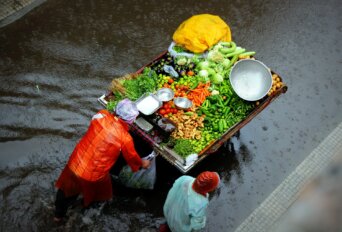- About
- Topics
- Picks
- Audio
- Story
- In-Depth
- Opinion
- News
- Donate
- Signup for our newsletterOur Editors' Best Picks.Send
Read, Debate: Engage.
| topic: | Natural disaster |
|---|---|
| located: | Pakistan |
| editor: | Kaswar Klasra |
Pakistan offers an unfortunately vivid example of a climate-crisis apocalypse following the devastating floods that have destroyed one-third of the country. Officials’ figures have revealed that approximately 1,550 people have died, 35 million people have been displaced, nearly 300,000 livestock killed, and 90,000 houses completely transformed into debris following the unprecedented floods caused by the melting of glaciers as global temperatures continue to rise year over year.
The water levels in parts of flood-hit areas have begun to recede, but it will take a minimum of six months until life becomes normal in flood-hit areas. Meanwhile, millions of flood victims are now stranded between life and death. The recession of water levels in flood-hit areas is indeed good news. However, water-borne diseases, including malaria, dengue fever, diarrhoea and skin conditions, have become the biggest issue that Pakistanis now face. The risk of these diseases dominated the discussion as authorities of Pakistan’s Sindh province sat down to discuss the post-flood scenario in the meeting.
The meeting was called in an emergency after 90,000 people, mostly children and women, were rushed to hospitals in a single day across the province after showing symptoms of one of these diseases. By Sunday, 18 September, hospitals across the province of Sindh had run out of beds; nevertheless, they continued to accommodate each new patient by making arrangements on an emergency basis.
Pakistan is one of the unfortunate countries across the planet that has to face the brunt of climate change. First, it was exposed to unprecedented monsoon rains in the south and southwest regions. These were followed by the melting of glaciers in northern areas, which triggered the flooding that has affected nearly 33 million people and caused nearly $30 billion in damage, according to governmental estimates.
Pakistan’s economists have claimed that the losses will restrict the country's annual GDP growth to 3 percent from the estimated target of 5 percent set out in its budget when the country had narrowly escaped defaulting on its debt in a balance-of-payments crisis. It is hard to imagine the suffering of a country that has been desperately working to secure a bail-out package of roughly $2 to $5 billion from the IMF and is then suddenly exposed to catastrophic floods causing $30 billion of damage to its economy.
The fact is that Pakistan was already reeling from economic blows when the floods hit, with its foreign reserves falling as low as one month's worth of imports and its current account deficit widening. Its currency is still tumbling, and inflation has topped 27 percent.
According to European Union data, Pakistan is responsible for less than 1 percent of the world's greenhouse gas emissions. However, the Global Climate Risk Index revealed that the South Asian nation is the eighth most vulnerable nation to the climate crisis and is paying a hefty economic and humanitarian price for developed countries’ activities.
Officials in Pakistan fear that recovery may be hampered by yet another catastrophic flood as the glaciers of Pakistan continue to melt quickly. Even if Pakistan attains net-zero carbon emission, this alone will not stop its glaciers from melting. It is paying a heavy price for wealthier nations’ emissions. To prevent these kinds of natural catastrophes in the future, the rest of the world must step up to play their part and reduce their contributions to global warming.
Photo by Milind Ruparel

